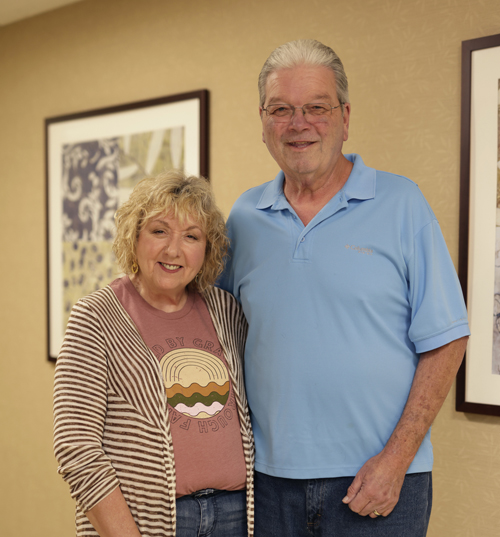by Matt Batcheldor
About 10 years ago, salesman Tony Conaway passed out in his customer’s shop, and that was the beginning of his heart failure journey.

After being taken to a community hospital near his home of Morris Chapel, Tennessee, he was diagnosed with a heart rhythm disorder that was the first sign of his cardiomyopathy, a disorder of the heart muscle function that can lead to heart failure. He was soon referred to the Vanderbilt Heart and Vascular Institute (VHVI) for specialized care.
In the ensuing years, Conaway began to develop increasing evidence of congestive heart failure and worsening kidney function, so he was referred for heart and kidney transplantation evaluation at VUMC. While hospitalized at Vanderbilt two years ago, his team helped remove excess fluid from his body and got him on the right combination of medications. He went home feeling much better, and it was determined that he no longer needed the transplantations.
Last winter, however, he again began to retain fluid, bringing back the shortness of breath for which he went back in the hospital. When it became impossible to keep his heart failure in balance at home, he considered having a device inserted into his chest to help monitor his heart pressures daily from home. He was evaluated by the Ambulatory Heart Failure Devices Program at VHVI, led by Sandip Zalawadiya, MBBS, associate professor of Medicine. While he could not qualify for a CardioMEMS implant (a device which directly monitors heart pressures), an opportunity arose to receive a new investigational device called the Cordella system.
This new device monitors not only his heart pressures but also his weight, heart rate, blood pressure and oxygen levels. Conaway is the first patient at Vanderbilt to receive this new implant.
“These devices are intended for heart failure patients who are at a high risk for admission to the hospital,” Zalawadiya said.
“These patients have either had previous hospitalizations for heart failure or have high levels of a circulating heart hormone called BNP or pro-BNP.”
The implantable devices such as CardioMEMS and the Cordella system offer peace of mind to heart failure patients such as Conaway, who lives more than two hours away.
The technology allows him to have fewer in-person appointments at VHVI for tests, such as heart catheterizations, and lets his team of doctors know what is going on with his heart.
“It’s enabled them to take better care of me and saves me from having to come so often from a long way away,” Conaway said.
Since its inception in late 2019, the Ambulatory Heart Failure Devices Program has come a long way. In March VHVI celebrated the milestone of having helped more than 100 heart failure patients with such implantable devices.
“The success of the Ambulatory Heart Failure Devices Program is a great example of what Vanderbilt does best — innovation and collaboration at multiple levels to improve patient outcomes,” said Kelly Schlendorf, MD, associate professor of Medicine and section head of Heart Failure and Transplantation.
Conaway was also the 500th person to get the Cordella system in a trial in which VHVI participated, Zalawadiya said.
“We have been able to help all types of heart failure patients through this journey,” Zalawadiya said, “including those suffering from heart failure with reduced ejection fraction, heart failure with preserved ejection fraction, congenital heart diseases, infiltrative heart diseases, pulmonary hypertension and those living with left ventricular assist devices and heart transplantation.”
The procedure to implant the device is a minimally invasive outpatient procedure and takes an average of 45-60 minutes to perform. Patients are discharged home the same day and can start using the device immediately.
Currently, Zalawadiya and Aniket Rali, MD, assistant professor of Medicine, perform these procedures.
Every morning, Conaway uses a handheld tablet that receives signals from the device. The tablet in turn sends the data to VHVI, which doctors monitor closely.
Lynne Stevenson, MD, professor of Medicine and director of the Cardiomyopathy program at VUMC, has been taking care of Conaway for the past two years, but has been working for more than 25 years to help apply remote hemodynamic monitoring to help manage heart failure between clinic visits.
“This technology opens a window to guide what we are doing,” Stevenson said. “It has been said that the ambulatory pulmonary pressures help understand heart failure the way the electrocardiogram has helped to diagnose cardiac rhythms.”
“When we see warning signs, we make changes and track responses to those changes,” said JoAnn Lindenfeld, MD, professor of Medicine. “The reason why this technology works is because we can detect abnormal changes in the heart early, and by correcting those changes, we can help improve their quality of life and prevent hospitalization for worsening heart failure.”
Conaway said Vanderbilt’s management of his heart failure has allowed him to resume living a normal life, including working in an outside sales position, boating and fishing.
He and his wife, Kim, just welcomed their fifth grandchild. They are looking forward to taking their family out on the lake in the pontoon boat they have just acquired.
“My group of doctors is very impressive, and they sure have impressed me,” Conaway said. “They’re caring and they’re smart and make you better, get you feeling well.”
Several dedicated members of the team share the success of this program, including the physicians, nurse practitioners (Natalie Castillo, Amy Howard, Donnalita Harmon, Michelle Parker, Linda Howerton (Retired now), Anna Peek, Amber Pollack, Sarah Stein, Rachel Fowler, Sarah Morgan, Samantha White, Allison Brown, Diana Davis, Jessica Zehring, and Casey West), nursing team led by Lori Poole, research team (Jaime Rich, Terry Weyand, and Sherry Bowman) and patient care specialist (Mary Sharp). We also would like to thank the cardiac catheterization laboratory staff (Rene Ooten, RN, Rebecca Johnson, RN and Christin Runnels, RN) for their help in assisting with the Cordella device implantation.












